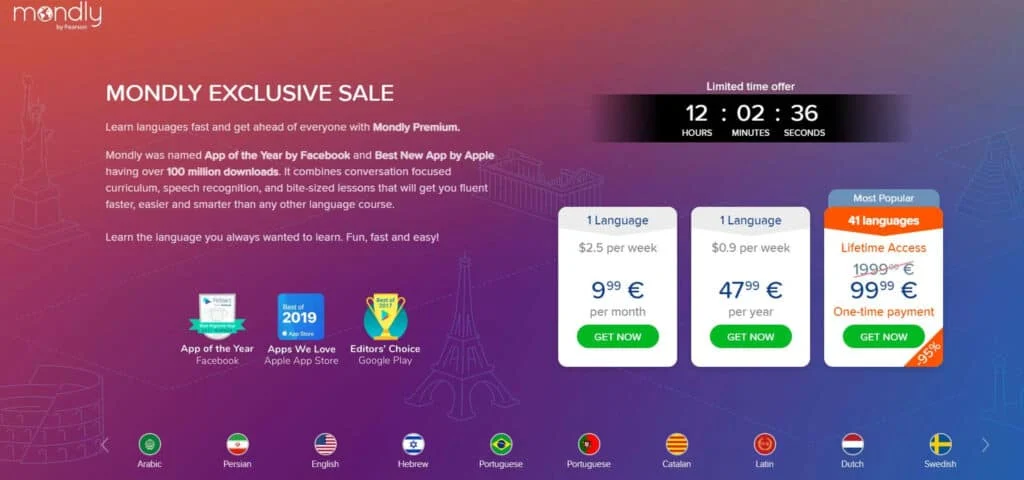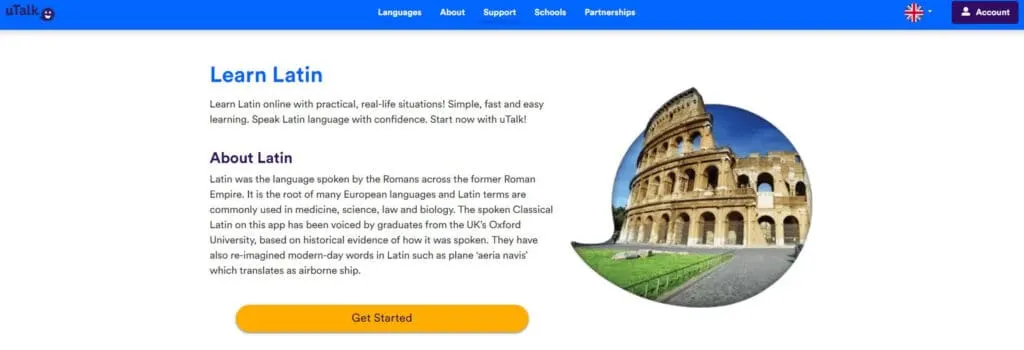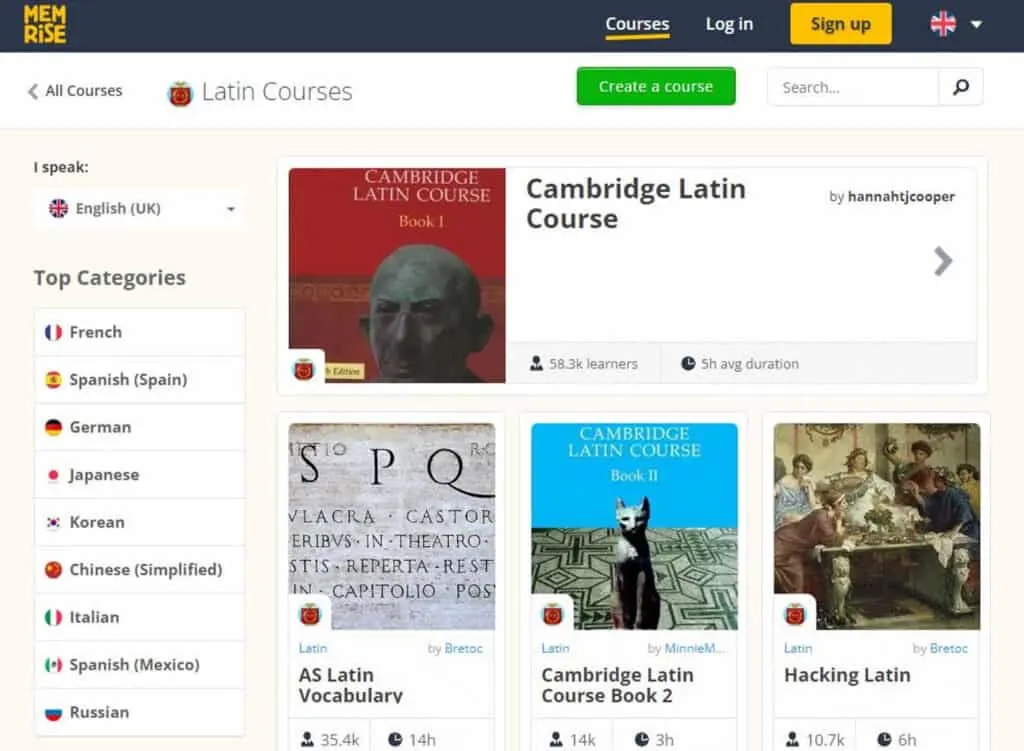As the root of many languages, Latin has been around for a long time. Nowadays, those of us who learn Latin are pretty rare. So, what apps are out there to learn Latin, and which are the best options for you to choose from? Let’s dive in and find out!
11 Best Apps to Learn Latin
So, if you want to learn Latin on the go or just want to dip your toe in the water of learning the language, here are some of the best apps to improve your Latin skills!
1. Duolingo
Let’s start the list with a popular language-learning app. If you want to improve your language skills, the first place you tend to go is Duolingo. Probably the most popular language app in the world, Duolingo uses bite-sized lessons and gamified learning to help you learn the basics of Latin.
Filled with different phrases and helpful tips on pronunciation, it’s no wonder it’s one of the world’s most popular apps. You can bring out your competitive side with leaderboards and XP challenges that help you rise through the ranks as you learn more Latin.
So many people get really into the different levels and leagues and it really helps with motivation, which can sometimes be lacking when you’re doing app-based language learning.
You’re also prompted to learn more by the infamous nudges and notifications from the Duolingo mascot, an owl named Duo. This is the nagware that launched a thousand memes.
Progressively getting more passive-aggressive the longer you ignore the app, this cartoon owl essentially guilt trips you into committing to your daily Latin language learning schedule.
This winning combination, together with a successful free version of the app, makes Duolingo a great option for learning Latin. There’s a reason this is many people’s go-to app for language learning anyway!
2. Rosetta Stone
As one of the classics of the language learning game, Rosetta Stone has been around for decades, so it’s no wonder that they have a pretty successful Latin course.
The fresh-looking app focuses on learning Latin vocabulary in context so that you can use cues and hints to actually understand the language, rather than just memorizing words and phrases and parroting them back out at a later date.

Rosetta Stone essentially tries to emulate the immersion method of learning that we all know works well for acquiring new languages, and distills it into an app version.
It does tend to be lacking when it comes to grammar rules and activities, but if you’re looking to boost your vocabulary skills and get a feel for Latin in both modern and ancient contexts, it’s well worth checking out Rosetta Stone.
3. Mondly
Looking for a fun app that gamifies learning Latin and actually makes it engaging? Mondly delivers simple and fun lessons that last around 10 minutes, meaning that you can fit it in no matter how busy your schedule might be!
Whether it’s quizzes, word scrambles, or gap-filling exercises, Mondly helps you to boost your Latin vocabulary skills in no time at all. One of the cool things about Mondly is that it features speech recognition software, so you can practice your pronunciation and speaking skills and gain meaningful feedback.

No one likes to mispronounce things in another language so this is a great feature to take advantage of within the app!
4. uTalk
If you want to actively speak Latin from the get-go, there’s probably no better app than uTalk for you to download.
Filled with a massive audio library jam-packed with Latin words and phrases, you can start learning practical Latin pretty much straight away. The more lessons you do, the more topics you unlock along the way, making it an ongoing Latin language journey.
The downside of uTalk is that there really isn’t any mention of Latin grammar rules. With Latin’s grammar being so tricky, it is hard to distill it into app form and still keep the user experience entertaining and engaging.

So, if you want to take your Latin to the next level, use uTalk alongside an app or language learning method with a slant toward grammar-based learning.
5. iTalki
We’ve briefly spoken about how one of the best ways to learn a language is by getting a one-to-one tutor to help you understand all the tricky nuances of this ancient language.
Unfortunately, there aren’t Latin tutors in every single town and city for in-person sessions. It’s just not realistic. That’s where iTalki comes in really handy to solve these kinds of accessibility problems.
The basic premise of iTalki is to connect language tutors and learners from all around the world so that they can conduct their lessons via video chat. You simply search for Latin and select a tutor from the list.

They all have their own rates and availability so see which ones fit with your schedule and life best. You can also read learner reviews to see what they think and see which time zone the tutor is based in. This is super important.
Your tutor doesn’t need to be in the same time zone as you, but it’s worth making sure that you can align your sessions so it’s not the middle of the night for one of you!
These digital tutoring sessions are really good for getting bespoke Latin lesson plans, tailored toward your overall language learning goals and objectives, whatever they may be. They can also correct you and help you hone your pronunciation and grammar skills along the way.
This is all super beneficial and something that you can rarely get from a pre-programmed app. It is more expensive than a lot of Latin language learning apps, but for the bespoke nature of the lessons, you can see where your money is going.
Each tutor sets their own hourly rate or offers block lesson deals, and this largely varies depending on experience and location. So, you should be able to find a cost-effective option for you.
6. SPQR Latin Dictionary and Reader
Reading in another language is an amazing way to learn in a particular context. With SPQR Latin Dictionary and Reader, you can take your Latin language learning to the next level.
Not only has it got a searchable version of one of the best Latin dictionaries on the market, embedded into the app, but you can also click on odd words and phrases as you read for translations, pronunciation notes, and context clues. It’s a super comprehensive way to learn Latin in a given context.
If you want to have some more fun or don’t feel like diving straight into reading in a foreign language, you can try out some of SPQR Latin Dictionary and Reader’s flashcards and quizzes that help you understand the complex grammar rules that often throw a lot of beginner Latin language learners off.
The app is also full of useful information on Ancient Roman history and culture to give you even more context to work with – it’s a complete package and one of the best Latin learning apps out there. Unfortunately, it’s only available on iOS at the moment, so if you’re on Android, you’re out of luck.
7. Mango Languages
Speaking of language learning apps that teach Latin with tons of contextual notes and cultural insights, we have Mango Languages. It’s much more user-friendly and less stuffy than SPQR Latin Dictionary and Reader, and by and large uses repetition to ensure that grammar, vocabulary, and pronunciation stick on a long-term basis.
This kind of spaced repetition is scientifically proven to improve language retention, which will help you remember those Latin words and phrases for years to come!
Mango Languages operates on the assumption that the majority of people learning Latin are doing so to read ancient or historical texts in their original language, which is a pretty safe assumption. So, it tailors its content to suit this purpose.
While it doesn’t go into a ton of detail when it comes to grammar – instead opting to teach it in context – Mango Languages does give you a well-rounded understanding of Latin. Combine this with the cultural insights it gives you along the way and it’s a great little app to learn Latin wherever you are in the world.
8. LingQ
We love immersion-based language learning! It’s by far the most effective way to learn a language and Latin is no different. The only difference is that it’s not widely spoken anywhere so you can’t really visit a place and be surrounded by the language 24/7 like you can with say Italian or Mandarin.
LingQ is designed to surround you with Latin-based media so it feels as if you’re immersing yourself in the language.
The app itself is filled with video and audio clips in Latin, with accompanying transcripts for you to go through at your own pace. You can either read along to help you gain context or you can test yourself and see how much you can understand when you’re unassisted.
The great thing about LingQ is that you can also add your own media to the app so if you have specific topics or pieces that you want to go through and understand different content, then you can access it on the go and get transcripts to also improve your reading skills.

So, it might seem like a listening-focused app, but it covers a variety of Latin language skills!
9. Memrise
If you’re looking for an app that isn’t specifically a language learning platform, but more of a revision tool, then Memrise might be right up your street. So, because it’s not a language-learning app, there isn’t a specific Latin track or journey that you can follow.
If you need that structure and support, this probably isn’t going to be the right kind of app for you. However, if you want to look for supplementary resources, Memrise is definitely a great place to start.
So, essentially, Memrise is a user-sourced revision platform where learners upload quizzes, presentations, media, and more that have helped them learn about a certain subject.
There are plenty of Latin-based resources available on the platform, so if you’re looking to boost your study or find advice for getting the hang of the tricky grammar, Memrise might just have the answer that you’re looking for!

Obviously, as it’s user-generated, take the resources with a pinch of salt as some of them may not be 100% accurate or correct. Realistically, Memrise is best used as a supplementary resource to help you revise, not as a primary way of learning Latin.
10. Clozemaster
Have you been learning Latin for a while and want to take your studies to the next level? Clozemaster clearly states that it’s a Latin learning app for intermediate and advanced learners, so if you’re a beginner you might want to put this one on the back burner.
Like many of the best Latin language learning apps, Clozemaster focuses on context-based lessons so that you can understand the language rather than just memorizing words and phrases.
Their main way of running lessons is through missing gap activities. Here, the app will give you a specific context and you have to work out the gap based on the information you’ve been given. That’s why it’s a little more challenging, and Clozemaster doesn’t have the same amount of engaging gamification that some of the other apps rely on.
It’s definitely more of a serious Latin learning app and does manage to balance vocabulary and grammar pretty well overall. If you’re looking for the next step in your Latin learning journey, this is a great app to do it.
11. Cattus Learn Latin
It’s no secret that Latin grammar and syntax are ridiculously difficult to get to grips with. Many language learning apps just skate over the grammar altogether in favor of teaching you basic phrases and vocabulary.
Cattus Learn Latin doesn’t shy away from grammar, in fact, it’s the primary focus of the entire app. That’s really what sets it apart from the crowd. The app does cover some vocabulary skills, but it’s kind of secondary to the grammar focus.
By taking the time and effort to break down common Latin words and phrases into their constituent parts, you can begin to understand the role that different words and syntax play. Once you understand the format and structure of the Latin language, you can begin to put together your own words and phrases.
This will also help you with your translations of ancient texts – something that is commonly done by the Latin language community.
It’s not the prettiest or most engaging app in the world, but if you want to understand and improve Latin grammar, Cattus Learn Latin is a great option to supplement your learning. Did we also mention that it’s completely free? Yep, it’s well worth downloading!
Who Speaks Latin?
Honestly, Latin is more of an academic and religious language nowadays. Used for the study of historical texts, culture, and art, it’s useful in a more academic regard, especially if you’re studying ancient history or art history.
On the other hand, if you’re going to Catholic mass or services, you’re likely to be familiar with some Latin. As a lot of the church was dictated to across Italy, Spain, and France, Latin was a common language that could be used across all countries, while still having a link and understanding with the other Romance languages.
So, if you’re a fan of the Catholic Church, or an academic studying Renaissance or ancient history, knowing Latin very well might help you deepen your study!
Why Learn Latin?
Learning Latin can be useful for a variety of reasons. If you’re looking to learn a lot of different Romance languages, knowing Latin can help you acquire them a lot easier as it’s the root of many languages, such as French, Spanish, Romanian, and more.
As we’ve already mentioned, it can also be helpful for academic purposes. Although there are largely translations of many important ancient and Renaissance-era texts, there is a lot that gets lost. If you want to experience stories and art in their original context, you’re going to need to learn Latin.
Is Latin a Dead Language?
The term ‘dead language’ is normally used when there are no speakers of that language left. Obviously, considering Latin is still a part of the church and academia, this is not the case.
It’s also still taught in a lot of private schools as a traditional course of study, so it’s definitely not a dead language – even if it’s not as prevalent as it once was. Technically, it’ll be classified as a dying or underused language.
Best Way to Learn Latin
There are quite a few ways to learn Latin. Realistically, unlike other languages, you can’t really immerse yourself in Latin as it’s not widely spoken by a population. Even if you go to Vatican City, you’ll definitely hear much more Italian than Latin. So, if immersion is out, what is the best way to learn Latin?
The best way to learn Latin is probably through one-to-one tutoring. This way, tutors can tailor the lessons and content to suit your individual language learning aims and goals.
It also has the benefit of being able to get corrected in real-time, before any bad habits or patterns crop up and cause trouble.
By and large, unless you’re going to Church, you’re primarily going to need to focus on reading and writing in Latin, rather than speaking and listening, so pronunciation may not be as much of a big deal as it is when you’re learning a language that’s more practically used in daily life.
It’s kind of hard to learn Latin in context unless you study history and the attitudes of the people who were around when the language was popular. It’s important to have the context to understand the meaning behind certain words and phrases that might be outdated or cannot be translated in a literal way.
Is Latin the Same as French or Spanish?
The short answer is no, Latin is not the same as French or Spanish. Although there are plenty of similarities between the languages, they are all different languages for different areas of the world.
Latin is the mother language for many of the Romance languages which is why a lot of the words, grammar rules, and phonology all kind of sound the same.
Want to learn Spanish? Take this free quiz to find out what your level is in Spanish on the CEFR scale (from A1 to C2!).
You can also take the test in French here!
Is it Hard to Learn Latin?
Honestly, the vocabulary isn’t too difficult as there is a lot of crossover with English, French, and Spanish. However, the grammar and cases can be really difficult to get your head around at first, which makes learning Latin especially tricky for beginners.
Many language learning apps do tend to focus on vocabulary and choose to avoid having the break down Latin grammar rules, so you might want to combine a couple of different language learning methods to improve both sides of this intriguing and ancient language.
Things like grammar books or worksheets alongside dictionaries or phrasebooks might work well as a compromise, giving you the best of both worlds.
Ready to Learn Latin?
So, if you’re looking to learn Latin on the go, there are plenty of amazing and varied apps for you to choose from.
Whether you want to spend your time working out the kinks of Latin grammar, want to boost your vocabulary bank, or just want to try and translate and understand some of your favorite ancient texts, you have a wealth of resources at your disposal.
Latin might not be as widely used as many languages that feature on these apps, but if you’re into the history, religion, or etymology of other more modern languages, learning Latin is a great way to spend your time and effort.
Which language learning apps do you like to use for boosting your Latin skills? Let us know in the comments below – we’d love to check them out!
Read More About Learning Language:
- What Are the Apss to Learn Greek?
- Apps to Learn Icelandic at Home
- What Apps Can I Learn Finnish?
- Where Can I Best Learn Sanskrit?
- Apps to Learn Croatian

Dayna Brockbank is a travel and language-learning blogger who has lived around the world but has now settled in Nice, France. She speaks 3 languages at varying levels of fluency: Spanish, Italian, and French, and graduated with a Bachelor’s in Spanish Education. She and her husband focus on making travel part of life by living cheaply and traveling on a budget.
